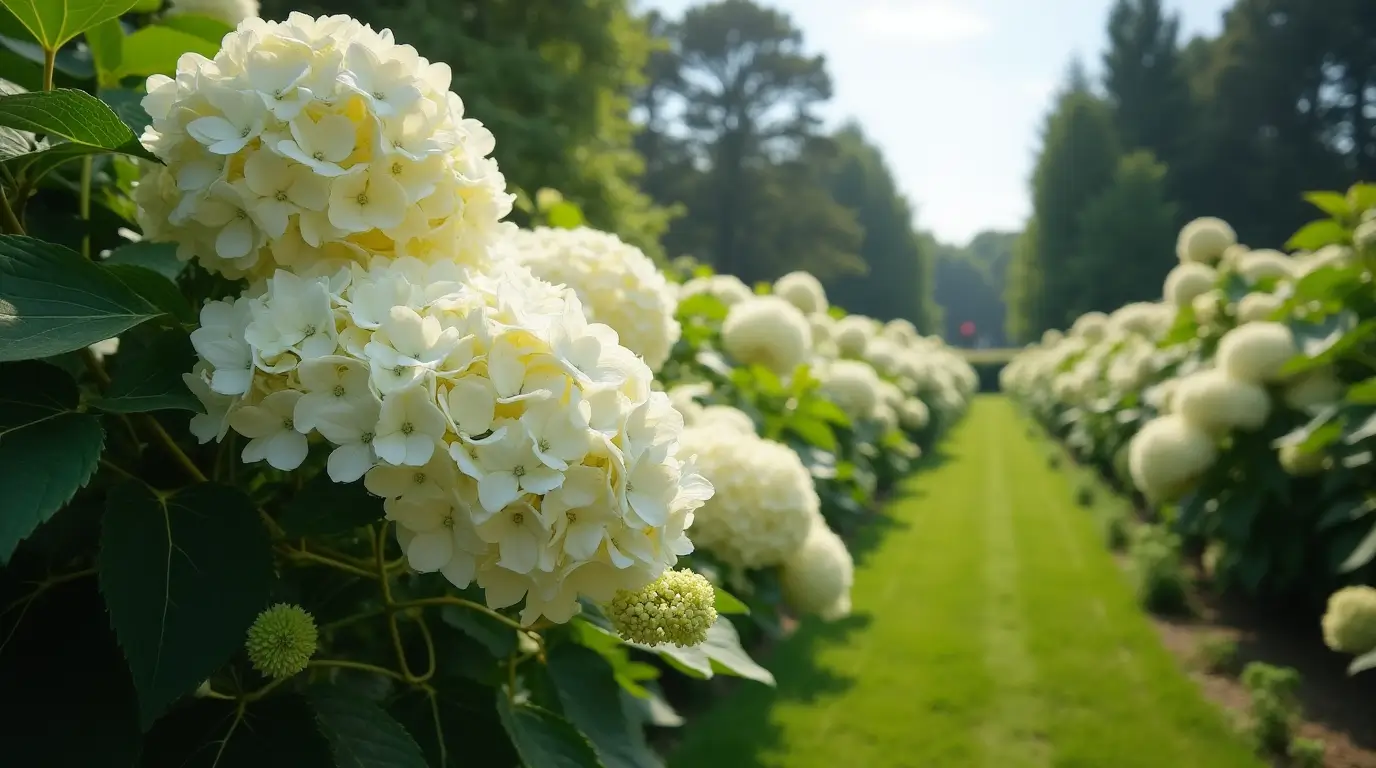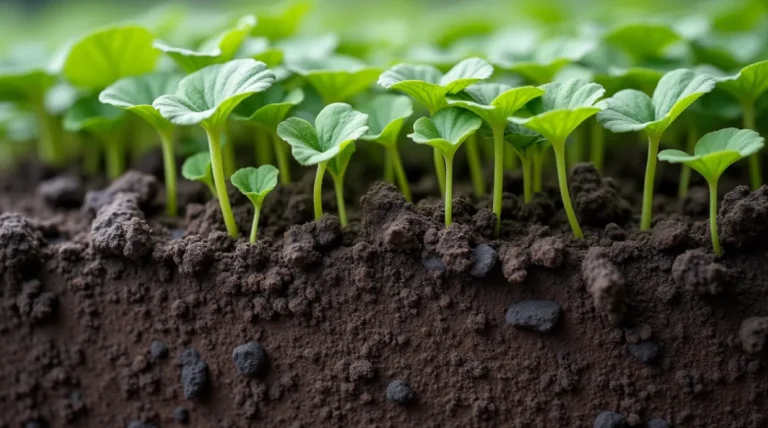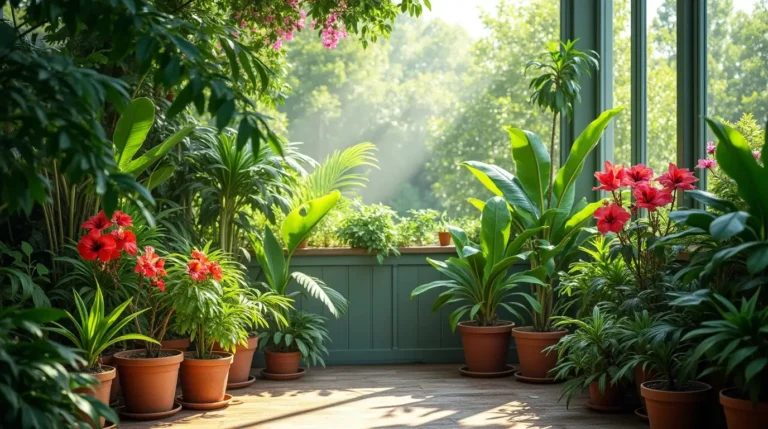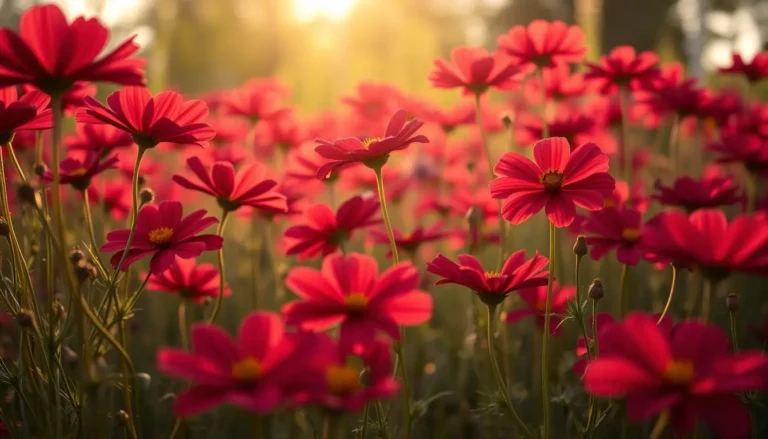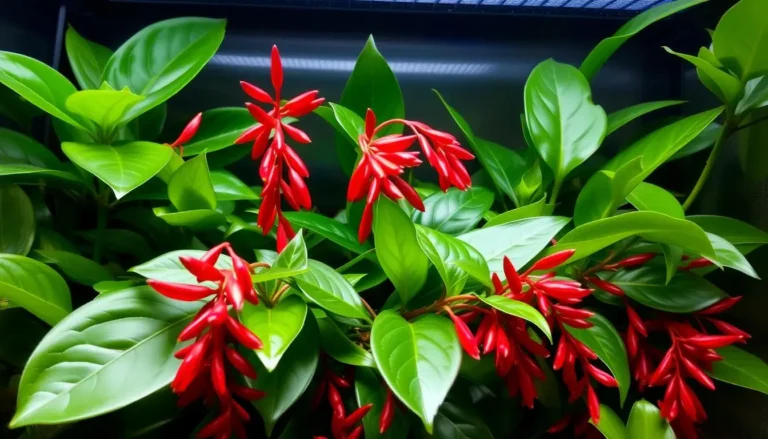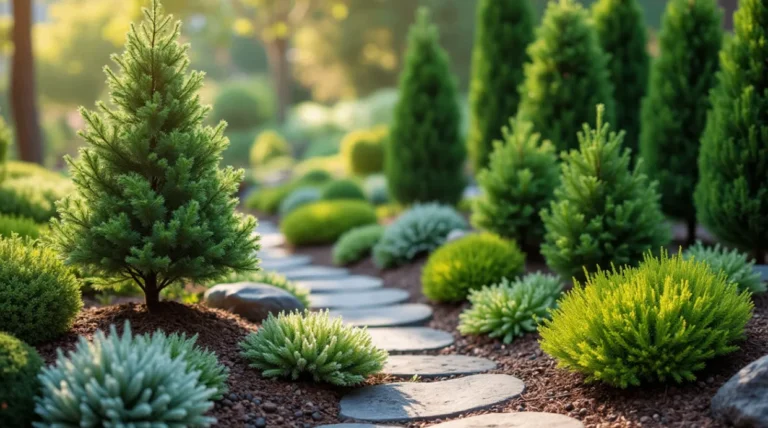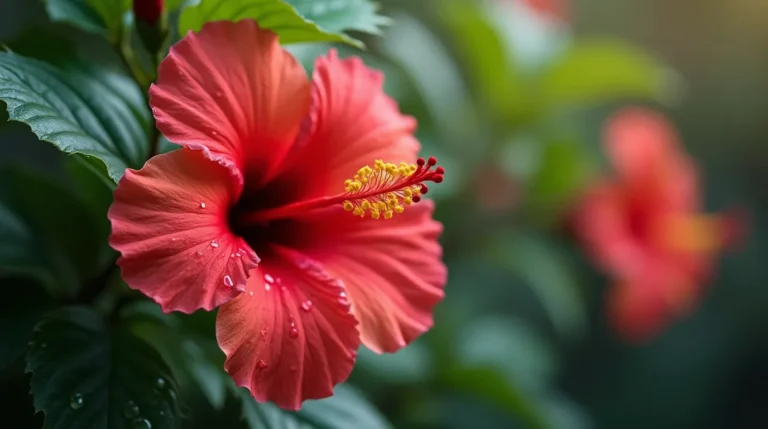Annabelle Flowers: How To Plant And Grow Like A Pro
Growing stunning Annabelle flowers is a rewarding experience for gardeners of all skill levels. These flowers are famous for their large, round white blooms. They add elegance to any garden.

To grow these gorgeous flowers well, you need to know the basics. With the right techniques and practice, your garden will bloom with Annabelle Flowers.
Key Takeaways
- Learn the optimal conditions for growing Annabelle flowers.
- Learn the proper care and maintenance techniques
- Discover tips for promoting healthy growth and blooming
- Explore common challenges and how to overcome them
- Enhance your garden’s beauty with these stunning flowers
Understanding Annabelle Flowers
Annabelle Hydrangeas are famous for their large, globe-shaped clusters of white blooms. They add beauty to any garden. These plants are also tough and easy to care for.
What Are Annabelle Hydrangeas?
Annabelle Hydrangeas come from Hydrangea arborescens, a shrub native to North America. Their flowers are large, similar to some hydrangeas, but they bloom on new growth. This makes them less affected by pruning times.
History and Origin
Annabelle Hydrangeas were introduced in the 1960s. They quickly became a favorite among gardeners. They are a special type of Hydrangea arborescens known for their large flowers.
Distinctive Characteristics
Annabelle Hydrangeas have big, round flower clusters. These can grow up to 12 inches wide. Their flowers bloom for a long time, adding beauty to gardens.
Flower Size and Appearance
One of the most striking qualities of Annabelle hydrangeas is their oversized, globe-shaped flower heads, each formed by countless petite florets that unfurl in mid-summer and remain vibrant through early autumn.
Growth Habit and Size
Annabelle Hydrangeas are deciduous shrubs. They typically reach 3 to 5 feet in height and width, forming a rounded shape. Regular pruning can help maintain their size.
Here are some key characteristics of Annabelle Hydrangeas:
- Large, round flower clusters
- Flowers on new wood
- Deciduous shrub
- Grows 3 to 5 feet tall and wide

Benefits of Growing Annabelle Flowers in Your Garden
Growing Annabelle Flowers in your garden is rewarding. They add beauty and offer many benefits. These flowers are a favorite among gardeners for good reasons.
Aesthetic Appeal Throughout Seasons
Annabelle Flowers look great all year. In mid-summer, their white blooms add elegance. Even when they’re not in bloom, their dried flowers remain beautiful.

Low Maintenance Requirements
Annabelle Flowers are easy to care for. They need little pruning and are simple to maintain. This makes them perfect for those who are new to gardening or are busy.
Versatility in Landscape Design
Annabelle Flowers fit well in many garden designs. They can stand alone, be part of borders, or mix with other shrubs. Their flexibility is a big plus.
Cut and Dried Flower Potential
These flowers are great for arrangements. Their big blooms are stunning in fresh bouquets. And their dried flowers are perfect for lasting arrangements.
| Benefit | Description |
|---|---|
| Aesthetic Appeal | Provides beauty throughout seasons with blooming flowers and dried winter interest. |
| Low Maintenance | Requires minimal care and pruning, ideal for busy or novice gardeners. |
| Versatility | Can be used in various landscape designs, from specimen plants to mixed shrub plantings. |
| Cut and Dried Flowers | Suitable for fresh floral arrangements and long-lasting dried arrangements. |
Ideal Growing Conditions for Annabelle Flowers
The right climate, sunlight, soil, and moisture are key for Annabelle Flowers to grow well. Knowing these conditions helps gardeners create a perfect environment. This environment supports healthy growth and lots of blooms.
Climate and Hardiness Zones
Annabelle Hydrangeas are hardy and grow well in USDA zones 3-8. They thrive in temperate regions featuring chilly winters and pleasantly warm summers. If you live outside these zones, you’ll need to protect your plants extra well.
Sunlight Requirements
Annabelle flowers grow best with a balance of sunlight and partial shade. The right amount of sunlight depends on where you live.
Full Sun vs. Partial Shade
In cooler climates, Annabelle flowers can tolerate full sun. In warmer areas, they thrive better with partial shade to prevent burning. Partial shade is best for the most blooms.
Regional Considerations
Consider your local climate when choosing the amount of sunlight. For example, in hot areas, morning sun and afternoon shade are good. This helps prevent scorching.

Soil Preferences
Annabelle Hydrangeas love well-draining, fertile soil rich in organic matter. The best soil pH is slightly acidic to neutral, between 6.0 and 7.0. Testing your soil can show its pH and nutrient levels.
- Check your soil to assess its pH levels and nutrient composition.
- Incorporate compost or other organic material to boost soil fertility and enhance drainage.
- Avoid planting in areas with standing water or where water tends to collect.
Moisture Needs
Annabelle Flowers need steady moisture, especially when they’re young. They require approximately 1 inch of water each week, either from rainfall or irrigation. Mulching helps retain moisture and maintain a cool soil temperature.
- Water Annabelle Flowers deeply once or twice a week, depending on the weather.
- Mulching helps retain moisture and maintain a cool soil temperature.
By knowing and meeting the ideal growing conditions, gardeners can enjoy Annabelle Flowers’ beautiful blooms for many years.
For additional guidance, head to the official website or browse recent updates for care and maintenance advice.
When to Plant Annabelle Flowers
To fully enjoy the stunning blooms of Annabelle flowers, be sure to plant them in the right season. The timing of planting significantly affects their growth and ability to bloom.
Spring Planting Guidelines
Spring is a favorable time to plant Annabelle Flowers. It gives the plants time to take root before the summer heat sets in. Ensure the soil has warmed up and the threat of frost has passed.
Fall Planting Benefits
Fall planting is another excellent option. It gives the plants enough time to develop their root system before winter. By getting an early start, you encourage healthier plants and more vigorous blooms in the next season.

Timing Considerations for Different Regions
The ideal planting time can vary depending on your location. Regions with mild winters can typically plant Annabelle Flowers in the fall, while those with harsher winters may be better off planting in the spring.
Knowing your local climate and average frost dates is essential for choosing the ideal time to plant Annabelle Flowers.
Selecting Healthy Annabelle Flower Plants
Vibrant Annabelle flower plants are essential for a stunning garden. Choose strong, healthy specimens free from stress or signs of disease when planting.
What to Look for at Nurseries
Visiting a nursery is a good way to find Annabelle flowers. Choose specimens displaying vibrant, abundant foliage and sturdy stems—and, if you’re able, take a moment to inspect their roots as well.

Container vs. Bare Root Plants
Annabelle flowers come in containers or as bare-root plants. Container plants have a better root system. Bare-root plants are cheaper but need more time to grow.
Signs of Healthy Plants
A healthy Annabelle flower plant shows certain signs. It has a strong root system and healthy leaves.
Root System Evaluation
A good root system is essential. For container plants, remove the plant to see the roots. They should be firm and not circling.
Foliage Indicators
The leaves should be a vibrant green, without spots or discoloration. Checking the leaves quickly shows the plant’s health.
| Plant Characteristic | Healthy Indicator | Unhealthy Indicator |
|---|---|---|
| Root System | Firm, well-developed roots | Circling, soft, or rotting roots |
| Foliage | Vibrant green, robust leaves | Discolored, wilted, or spotted leaves |
Site Preparation for Planting Annabelle Flowers
To give your Annabelle flowers the best start, thorough site preparation is essential. This process involves several key steps that will ensure your plants thrive in their new environment.
Choosing the Right Location
Selecting the right location for your Annabelle flowers is critical. These plants prefer partial shade to full sun and well-draining soil. Take into account each plant’s full-grown size when picking its spot to prevent overcrowding.
Soil Testing and Amendment
Soil testing is a crucial step in preparing your site. It helps determine the pH level and nutrient content of your soil.
pH Adjustment Techniques
If your soil test reveals that the pH is too high or too low, adjustments will be necessary. For Annabelle flowers, a slightly acidic to neutral soil pH (around 6.0-7.0) is ideal. To modify the soil pH, add lime to increase it or sulfur to decrease it.
Adding Organic Matter
Incorporating organic matter such as compost or well-rotted manure can significantly improve soil structure and fertility. This step is essential for providing your Annabelle flowers with the necessary nutrients for healthy growth.
| Soil Type | pH Adjustment | Organic Matter Addition |
|---|---|---|
| Clay Soil | Add lime if too acidic | Compost or manure |
| Sandy Soil | Add sulfur if too alkaline | Compost or peat moss |
| Loamy Soil | Monitor pH regularly | Compost or well-rotted manure |
Spacing Considerations
Proper spacing is vital to prevent overcrowding and ensure good air circulation around your Annabelle flowers. Typically, these plants should be spaced about 3-4 feet apart, depending on the variety.
By following these site preparation steps, you can create an optimal growing environment for your Annabelle flowers, setting them up for success and beautiful blooms.
Step-by-Step Planting Guide for Annabelle Flowers
To grow Annabelle Flowers well, follow this step-by-step guide. Planting them right is key for their growth and blooming.
Tools and Materials Needed
First, get the tools and materials you need. You’ll require a garden fork, a shovel, compost or well-rotted manure, and a watering can or hose.
- Garden fork
- Shovel
- Compost or well-rotted manure
- Watering can or hose
- Mulch (optional)
Digging the Planting Hole
Excavate a planting hole twice the width of the root ball and matching its depth. If your soil drains poorly, raise the bed to help.
Proper Planting Technique
Planting Annabelle Flowers is a bit different for container-grown or bare-root plants.
Container Plants
For container plants, carefully remove the plant from its container. Be gentle with the roots. If they’re circling, gently tease them apart with your fingers.
Bare Root Plants
For bare-root plants, soak the roots in water for a few hours before planting. Gently fan out the roots before positioning the plant in the hole.
| Plant Type | Pre-Planting Care | Planting Technique |
|---|---|---|
| Container Plants | Spread roots out in the planting hole | Gently tease apart circling roots |
| Bare Root Plants | Soak roots in water | Spread roots out in planting hole |
Initial Watering and Mulching
After planting, water your Annabelle Flower well to settle the soil. Then, add a layer of mulch to keep moisture in and weeds out.
For more detailed guidance and visual instructions, consider watching Annabelle Flowers videos that demonstrate these steps.
Watering Techniques for Annabelle Flowers
To keep your Annabelle Flowers looking great, it’s key to know how to water them right. These flowers need steady moisture, especially when they’re growing, to show off their beautiful white blooms.
Establishing Watering Schedules
Setting up a watering routine is important for your Annabelle Flowers’ health. Provide a thorough watering session once or twice weekly, adjusting for temperature and humidity. In the hot summer, they might need more water.
Signs of Under and Over-Watering
Knowing the signs of too little or too much water is crucial. If your Annabelle Flowers’ leaves are wilted, they might not have enough water. On the other hand, too much water can cause root rot and yellow leaves. Change your watering plan to avoid these problems.
Drought Tolerance and Management
Annabelle Flowers like moist soil but can handle some dry spells. But long dry periods can hurt their blooming. Mulching around the plants helps keep the soil moist and cuts down on the need for constant watering.
Efficient Irrigation Methods
Using smart watering methods like soaker hoses or drip irrigation is a good idea. Employ drip irrigation to deliver moisture directly to the root zone, minimizing evaporation and runoff. This way, your Annabelle Flowers get the moisture they need.
- Water Annabelle Flowers in the morning to minimize evaporation.
- Avoid getting water on the leaves to prevent fungal diseases.
- Modify your watering frequency in response to rainfall and by monitoring soil moisture levels.
Fertilizing Annabelle Flowers for Optimal Growth
To make Annabelle Flowers thrive, a good fertilization plan is key. Fertilizing helps them grow strong, bloom well, and stay healthy.
Types of Fertilizers to Use
Choosing the right fertilizer is crucial. Annabelle Flowers need a balanced diet of nutrients to grow well.
Balanced vs. Specialized Formulas
A balanced fertilizer with a 10-10-10 N-P-K ratio is best for Annabelle Flowers. Some gardeners also use special formulas for flowering plants.
Slow-Release Options
Slow-release fertilizers are great. They give nutrients slowly, so you don’t need to fertilize as often. This also helps avoid over-fertilizing.
Fertilizing Schedule and Frequency
How often to fertilize depends on the fertilizer and the plant’s stage. Early spring and after blooming are good times to fertilize.
Organic vs. Synthetic Options
Organic and synthetic fertilizers are both options. Organic fertilizers come from nature and help the soil. Synthetic fertilizers work fast but need more frequent use.
Choosing organic or synthetic fertilizers depends on your goals and what you prefer. Both can work well if used right.
Pruning Annabelle Flowers: Techniques and Timing
To keep your Annabelle flowers thriving, understanding pruning is key. Pruning is more than cutting stems. It promotes healthy growth, encourages blooming, and keeps your plants looking great.
Why Pruning is Important
Pruning Annabelle flowers is vital for their health and blooms. It removes dead or damaged stems, improves air circulation, and lets more sunlight in. This reduces disease risk.
Regular pruning also stimulates new growth, leading to more blooms.
When to Prune
The best time to prune Annabelle hydrangeas is in late winter or early spring. Prune before new growth starts. This way, you avoid cutting off buds that will bloom.
Different Pruning Methods
The pruning method you choose depends on your goals. For Annabelle flowers, there are two main methods:
Hard Pruning for Larger Blooms
Hard pruning cuts stems back to 6-12 inches from the ground. This method can lead to bigger flowers since the plant focuses energy on fewer stems.
Light Pruning for More Numerous Flowers
Light pruning removes just the tips of stems or lightly shapes the plant. This can result in more flowers, though they might be smaller.
Tools and Techniques
To prune well, you need the right tools. Use sharp, clean pruning shears or loppers to make clean cuts just above a bud eye. This helps the plant heal fast and reduces disease risk.
Also, sterilize your pruning tools between cuts, especially when pruning diseased plants. This prevents disease spread.
Companion Planting with Annabelle Flowers
Companion planting with Annabelle Flowers can make your garden more beautiful and diverse. By choosing the right plants, you can make your garden look great and thrive.
Compatible Plants
Annabelle Flowers look good with many plants. Some great choices include:
- Hostas, which provide contrasting foliage
- Daylilies, offering complementary blooms
- Boxwood, for a structured hedge
- Ornamental grasses, adding texture and movement
These plants not only match Annabelle Flowers but also make your garden strong and varied.
Design Principles
When designing a garden with Annabelle Flowers, think about layering, texture, and color contrast. Layering means using plants of different heights. Texture comes from the leaf and bloom types. Color contrast happens when you pair Annabelle Flowers with plants of different colors.
Creating Seasonal Interest
To keep your garden interesting all year, use plants that bloom at different times. For example, spring bulbs like tulips or daffodils can bloom before Annabelle Flowers. Then, asters or chrysanthemums can bloom in the fall.
Color Combinations
Annabelle Flowers have white blooms that look great with many colors. Try pairing them with pink, purple, or yellow plants for a bold look. For a softer look, match them with white or cream-colored plants.
By using these companion planting tips, you can make your Annabelle Flowers stand out and create a lively garden.
Troubleshooting Common Annabelle Flower Problems
Annabelle Flowers are easy to care for, but sometimes issues can pop up. Knowing how to fix these problems can keep your plants looking great.
Drooping or Floppy Stems
Stems that droop or flop often mean the plant needs support or too much water. Using stakes or cages can help. Also, make sure not to water too much.
Lack of Blooms
Not getting blooms can be due to bad pruning, not enough sunlight, or not enough nutrients. Make sure your plants get enough sunlight. Prune them in late winter or early spring for best results.
Leaf Issues
Yellow leaves or spots can mean pests, diseases, or bad environment. Check your plants often to catch problems early. Fungal diseases can be treated with special sprays.
Flower Color Changes
Changes in flower color are usually okay, as Annabelle Flowers are known for their white blooms. But, knowing that soil pH can change hydrangea colors is key. Since Annabelle Flowers are a type of Bigleaf Hydrangea, they’re less likely to change color.
| Issue | Cause | Solution |
|---|---|---|
| Drooping Stems | Inadequate Support or Excessive Watering | Provide Stakes or Cages, Adjust Watering |
| Lack of Blooms | Improper Pruning, Insufficient Sunlight, Nutrient Deficiencies | Prune Correctly, Ensure Adequate Sunlight, Fertilize |
| Leaf Issues | Pests, Diseases, Environmental Factors | Inspect Regularly, Treat Pests or Diseases, Adjust Environmental Conditions |
For more help and tips, check out annabelle flowers videos or the annabelle flowers official site. These resources offer more advice on keeping your Annabelle Flowers healthy and beautiful.
Pests and Diseases of Annabelle Flowers
Annabelle Flowers are easy to care for but can still get pests and diseases. Keeping an eye on them and taking action is important. This helps them stay beautiful and healthy in your garden.
Identifying Common Pests
Annabelle Flowers face pests like aphids, scale insects, and spider mites. These pests harm the plant by sucking its sap. This weakens the plant and can spread disease.
Aphids and Scale Insects
Aphids are small, soft insects found on Annabelle Flowers’ stems and leaves. Scale insects look like small, still bumps on the plant. You can manage both by applying either insecticidal soap or neem oil.
Spider Mites
Spider mites are tiny, spider-like bugs that can turn leaves yellow or bronze. They like dry places, so keeping the area moist helps prevent them.
Disease Recognition and Prevention
Annabelle Flowers can also get diseases like powdery mildew and leaf spots. Keeping your garden clean and watering it properly can stop these problems.
Powdery Mildew
Powdery mildew looks like a white, powdery film on leaves. Remove sick leaves and make sure plants have good air flow to manage it.
Leaf Spot Diseases
Leaf spot diseases make spots on leaves that can cause them to fall off. Use fungicides to treat it, but preventing it is better.
Organic and Chemical Treatment Options
There are organic and chemical ways to fight pests and diseases. Organic methods include neem oil, insecticidal soap, and introducing helpful insects. Chemicals like fungicides and insecticides work too, but use them carefully to protect good bugs.
Conclusion: Enjoying Your Beautiful Annabelle Flowers
Growing Annabelle Flowers can be very rewarding. With the right care, these beautiful blooms can thrive in your garden. Understanding the ideal growing conditions and care is key to enjoying their stunning white flowers all season.
To keep your Annabelle Flowers looking their best, check out our annabelle flowers website for more gardening tips. Our annabelle flowers bio section has detailed info on their history and growing habits. You can also find inspiring photos of Annabelle Flowers to see their beauty in different gardens.
By following the guidelines in this article, you’ll enjoy the beauty of Annabelle Flowers in your garden. With the right care, these lovely plants will keep thriving and show off their stunning white blooms for years.
FAQ
What are Annabelle Flowers, and how do they differ from other hydrangeas?
Annabelle Flowers are a special type of hydrangea called Hydrangea arborescens ‘Annabelle’. They stand out with their big, round white flower clusters. They also bloom on new wood, making them a favorite among gardeners.
How do I care for Annabelle Flowers after planting?
To care for Annabelle Flowers, make sure they get enough water, especially when they’re young. Feed them a balanced fertilizer every year. Prune them in late winter or early spring to help them grow and bloom well.
Can Annabelle Flowers thrive in full sun, or do they require partial shade?
Annabelle Flowers can handle different light levels, from full sun to partial shade. In hot places, some afternoon shade helps prevent burning. In cooler areas, they can handle full sun.
How often should I water Annabelle Flowers, and what are the signs of over-watering?
Water Annabelle Flowers often, especially when it’s dry. Keep the soil moist but not too wet. Indicators of overwatering include yellowing leaves, wilted stems, and root rot.
What is the best time to prune Annabelle Flowers, and how should I prune them?
Cut back Annabelle hydrangeas during late winter or early spring. Trim the stems down to approximately 3 to 4 inches above the ground. This encourages new growth and more blooms.
Are Annabelle Flowers deer-resistant, and how can I protect them from pests?
Annabelle Flowers are not deer-resistant, but deer don’t usually eat them. To keep pests away, use repellents, fencing, or other deterrents as needed.
Can I grow Annabelle Flowers in containers, and what are the requirements?
Yes, you can grow Annabelle Flowers in containers. Use a big container with good drainage. Choose a potting mix that drains well, and make sure the plant gets enough water and fertilizer.
How do I propagate Annabelle Flowers, and what are the best methods?
You can propagate Annabelle Flowers by division, stem cuttings, or layering. Division works best in spring or fall. Take stem cuttings in summer.
What are some common companion plants for Annabelle Flowers?
Good companion plants for Annabelle Flowers include hostas, astilbe, and ferns. You can also pair them with plants that bloom at different times and colors for a lively garden.
Where can I find more information on Annabelle Flowers, such as on the Annabelle Flowers website or through official sources?
For more info on Annabelle Flowers, check out gardening websites, talk to local nurseries or gardening experts. You can also visit the official websites of hydrangea associations or gardening organizations for care, propagation, and troubleshooting tips.

